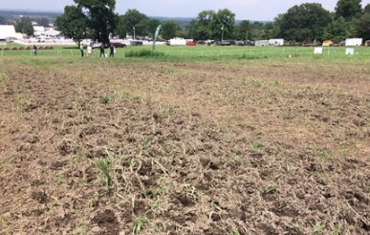By Sjoerd Willem Duiker
Managing soil compaction while grazing can be a challenge in a wet summer like we are experiencing now, but it can be done, as we learned last week at Ag Progress Days.
Last week at Ag Progress Days I participated in a Management Intensive Grazing demonstration with USDA-NRCS Grazing and Soil Conservation Specialists. It rained much of Tuesday, after which it became sunny on Wednesday and was dry on Thursday. The soil of our grazing demo was an Andover poorly drained channery silt loam soil on an 8-15% slope. This soil has a shallow fragipan which is almost impervious to water, so it has a seasonally high water table. In fact, water was still standing in some pockets of the field while cattle were grazing. Half of our field was in a tall fescue/ orchardgrass sod that had been in place for many decades, while others were sod that had been terminated last year and planted in summer annuals for our demonstration. We managed this half as no-till. In early July of last year we planted a highly diverse mixture of summer annuals in this field (Iron and Clay Cowpeas, AS 6501 Sorghum Sudangrass, Daikon Radish, Wonderleaf Hybrid Pearl Millet, AS6401 Sorghum Sudangrass, Peredovik Sunflower and T-Raptor Hybrid Brassica), which was followed by a spring triticale/spring pea mix this spring that was terminated with glyphosate, after which we planted different summer grazing mixes in this field.
Here are some of the take home lessons for managing soil compaction when grazing in a wet summer:
- Keep the animals on a hard surface area (or, less desirable, a sacrifice lot) and feed them hay if you are not able to move them frequently during excessively wet conditions. However, remember that the cost of feeding hay is at least twice that of grazing, so it pays to maximize grazing.
- Move the animals frequently. By leaving the animals in an area for only a short time using temporary fencing you limit hoof impact. We noticed more damage as the cows went over the same area multiple times. By moving the animals every three hours and excluding them from the previously grazed area by backfencing, we were able to graze even when it was raining without excessive damage to the field. We also moved the water, so the animals did not have to go back to the same spot to drink. When the rain stopped, and the field dried out, we could move them less

Hoof divots caused by cattle after they have grazed an area. Even though it appears to be muddy and have depressions, there are still growing plants and vegetation which will result in a quicker recovery of the pasture (S. Duiker)
- Put the animals on tall fescue when it is wet. The old tall fescue/orchardgrass mix was able to sustain animal impact much better than the annuals we had planted. Although tall fescue has gotten a bad reputation due to endophyte infection, it can be your saving grace in a wet spell. Tall fescue has a very robust root system that holds up the animals. If you offer the fescue with other species such as orchard grass the animals graze it well.
- Use permanent no-tillage. As soon as the surface dried out on the second day of our demonstration we were able to graze the annuals without very detrimental effects on the soil. By using no-tillage we were able to maintain the granular soil structure that had developed under decades of sod. If you grow annuals that winterkill, it is important to plant a cover crop to always maintain a living root system in the soil.
- Rotate annuals with perennials. We typically assume 40% of the total plant mass of a perennial is below the ground, while it is 20% for annuals. The bigger root mass helps improve the soil and limits the impacts of compaction in the rotation.
- Don’t overgraze. While there are differences of which metric to use, all grazing specialists agree that you should leave adequate leaf area for regrowth. This helps strengthen the root system. We typically use the rule of graze half, leave half, while others may graze to a certain height such as 4 or 5 inches. The animals may trample part of the biomass onto the soil surface and this is fine because it will recover or become food for the biological organisms in the soil.
- Use long rest periods. Before you send the animals in again, wait at least 20-30 days until you have a vigorous stand again (monitor the vegetation).
- Manage the belowground herd. By taking care of your soil first you can make it more resilient, so it withstands compaction better and it also recuperates better. We noticed tons of earthworm middens in the field that will do their tunneling and processing of soil, for example, to make the soil porous and crumbly again.